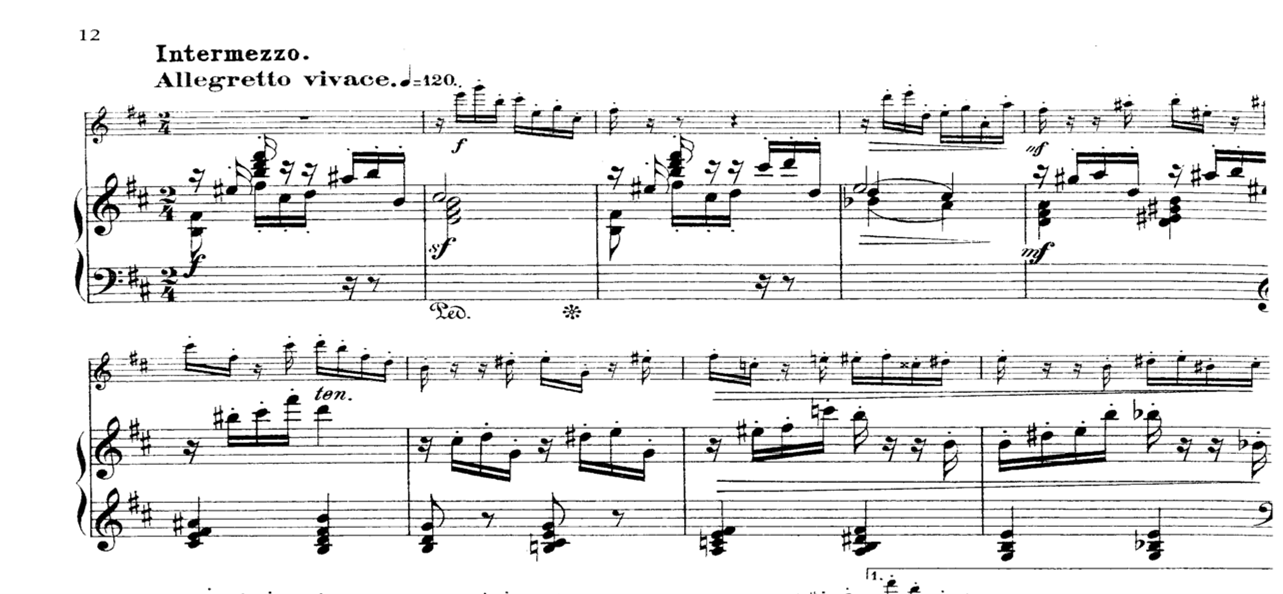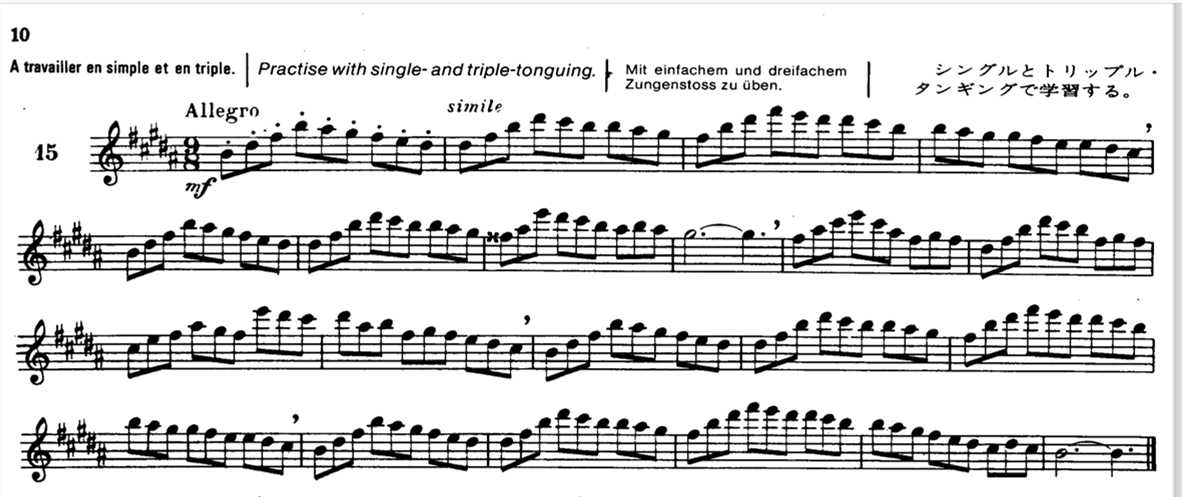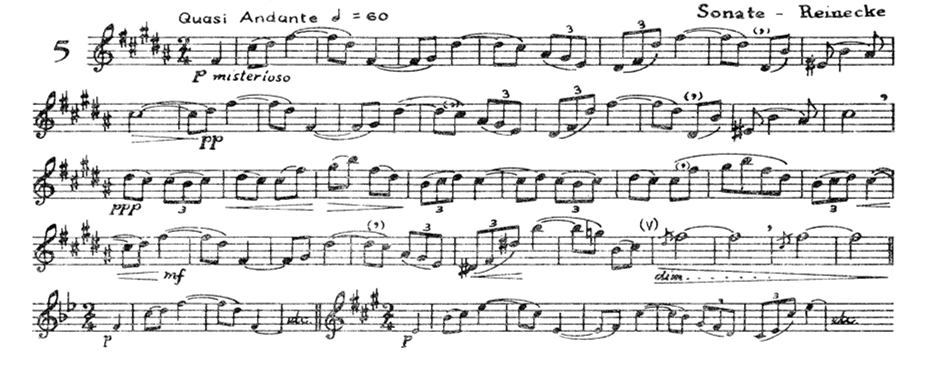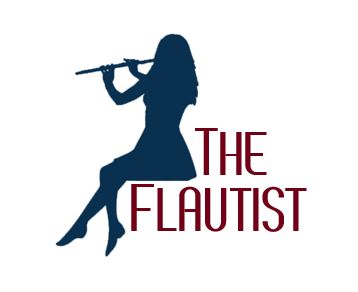Sonata in E minor Intermezzo. Allegretto vivace “Undine”
by Carl Reinecke
Eileen Gilligan Flute and Xinyu Allie Wang Piano – Sonata in E minor Intermezzo. Allegretto vivace “Undine”
Intermezzo. Allegretto vivace is the second movement of the Carl Reinecke Sonata and the second part of Undine and Huldbrand’s love story. We see Undine, her flirtatious, romantic nature and get introduced to Huldbrand for the first time.
Before commencing playing this movement sit down with the full score, try to hear the overall work musically and the shape of it. Look for conversations, colour changes and stylistic opportunities, what is it saying?
Fundamental aspects that should be considered- Firstly, what is an Intermezzo?
An intermezzo is light in character and played between outer movements which are larger in form. By its very name it comes between compositions or movements. In this case one and four.
Secondly, Allegretto vivace seems to contradict itself.
Allegretto, is generally associated with a dance or graceful style of composition. Vivace is very fast. So, there is the conundrum – a very fast, graceful, dance like movement? Play it too fast and it loses it grace, too slow and it becomes laboured. I find the tempo finds itself when the player has explored the skeleton. For players learning about skeletons, they are the basic structure eg, the first note of every 4 played in crotchets. In this case 2 crochet beats in a bar.

Looking at the music above where there are 8 semiquavers it would be the first of every four and where there is a rest for the first semiquaver choose the second half of the beat and play as a quaver, so it will feel like an upbeat. When the skeleton feels beautiful and flows just add some of the other notes bit by bit and voila!!! There it is. This shows the underlying musical beauty and shape of the melody or section.
Once these things have been sorted in the players mind it will be easier to determine a style and tempo.
The second part of the thought process is what is the story we are going to tell or emotion we are going to depict like the first movement.? I chose to relate to the novel in this movement because everything pointed to a flirtatious romantic interlude between Undine and Huldbrand . The staccato passages are a conversation between Undine represented by the flute at times and also between her and Huldbrand being the piano. The conversations are important to identify and make musically clear. It is flirtatious and coy at times in the flute part. The piano has an unusual compositional solo which is rather long. I relate it to Huldbrand, as it is strong and forward moving in character. Total contrast to the light staccato melodies in the flute. This movement is really introducing the two main characters to us.
One can look at the form, it won’t help interpret the movement too much because of the thematic material being the same three times.
There are no direct quotes or directives from Reinecke, so it is up to the player to look, listen and feel their way through.
Once the player has thought about these aspects, the tempo, style and approach to the staccatos will be clear to them.
Choosing the style of the staccatos will be important to the overall musical presentation of the movement. I am very much French School in style and love resonant and musical notes, so this is what I chose musically. It is personal taste, but the most important thing is to know why one does something musically as a player and to have thought about it.
To help practice for this movement, Marcel Moyse playing 24 Little Melodic Studies No.15- I refer to this study a lot for musical, resonant staccatos. Percussive tonguing and clipped notes were not a big part of the French School or Moyse style. I also don’t find them musical and expressive. Moyse was always talking about life in a note and light in the music. I think this little study really helps with that in staccato passages especially his introduction to the study. It is however a personal choice as to how to interpret the staccatos. Take note of the ends of the phrases as to the length of notes whether they are quavers or crotchets and staccato or not. The devil is in the detail.
Marcel Moyse
Playing his study No. 15

The romantic theme in the movement is used by Moyse as No.5 in Tone Development Through Interpretation. It needs to be warm and expressive in contrast to the light playful material. Whenever I get to that melody, I embrace it with love and a full tone. It is just such a wonderful melody to play. This is where the player will reap the rewards of the Foundation Tools and Tone Development Through Interpretation as well as the vocalisations because they will be able to launch into a warm, full expressive tone straight away. It needs to reflect the love Undine felt and her passion. Even though it is marked p, the tone can still project and have musical depth if the harmonics are there. A quote from William Bennett I will never forget is “if the harmonics are not in tune, then the sound doesn’t add up”. Powerful words and so true. I think this quote should be at the top of every flute tutor book that is published along with “it is the way one comes in and out of the breath that matters” by Stephen Preston. Tricky little things though. It is marked Misterioso, incorporate that sense in the colour, but it is a love theme, so try for a balance between the two. This is a situation where feelings about the musical writing of the composer can influence performance. Feelings and feeling one’s way through musical phrases is so important. It can totally change a musical outcome for a player.

Marcel Moyse
Playing his study No. 1
Moyse playing Melodious study number 1 complete with bell tones. I always come back to this study for repeated notes, holding and shaping a musical line and expression. This is what is needed for the romance theme.
The player can make up words to help with musical expression. Doesn’t matter what they are as long as they aid depth of expression. An example would be “I LOVE you so,I DO love you so,” for the opening phrase etc and follow a similar pattern all the way through the theme.
The most important beat of the bar is the first in any time signature. The player needs to head towards the first beat musically every time. Always know where we are going phrasing wise.This movement is a classic case of this, or it won’t work musically. It will wander aimlessly. The love theme has to embrace the first beat with warmth every time, typical {love} examples.
These are my thoughts, and they work for me musically. As long as the player is convinced about their approach and story no matter what it is, it will work musically. The real key is to think about what we are going to play, say and what the music is telling us. We owe it to the composer and to ourselves.
This approach and practice will enable the expression of this movement’s love story.
